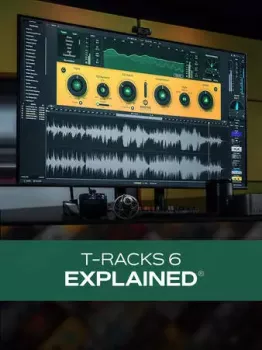Last updated 7/2020
MP4 | Video: h264, 1280x720 | Audio: AAC, 44.1 KHz
Language: English | Size: 2.25 GB | Duration: 1h 42m
英文简介:
Expand your technical skills, improve your fretboard knowledge and optimize your practice routine
What you'll learn
A foundation for learning music faster
Practice in a way that forces improvement
Optimize your practice routine
Get started with fingerpicking
Build picking speed (with alternate picking)
Develop better precision and accuracy
Requirements
Have a guitar (to practice with)
Available daily practice time (~5-30m)
Description
Whether you're a guitarist who's been at it for years or a new player, chances are that you've developed many habits... and not always the good kind. In this course, I'm sharing some of my private students' most valued first-hand lessons - how to develop good guitar habits.In this course, you'll learn how to play anything (chords, scales, etc.) in all 12 keys and you'll learn how to practice effectively and efficiently. The sections on playing in 12 keys will give established beginners (and transitional intermediate players) a much more complete understanding of how musical keys map out across the guitar fretboard AND how to use that to their advantage. The section on practice routines will outline recommendations for refining, expanding and optimizing your practice time so that you can get even more out of the same time commitment. In between these fundamental training sections are two sections on alternate picking and fingerpicking - 2 areas where I see my private students developing their bad habits most often. The purpose of these sections is to establish clear guidelines for learning and practicing these important skills.Develop good habits and an optimized practice routine to see better resultsStay focused and stay encouragedGet recommendations for improving your picking speed and precisionNo-nonsense kickstarter for adding fingerpicking to your repertoireTry new things and expand your horizons on guitarContents and OverviewAfter an orientation that will help you understand what to expect and how to succeed, you'll get 4 distinct training sections. Each section will isolate the method for acquiring new skills and learning to practice them in a productive, engaging way.Following one after another, the courses 4 primary sections will address (1) Practicing in 12 Keys, (2) Alternate Picking Essentials, (3) Fingerpicking Essentials and (4) Practice Routine & Visualization. Each section simulates a series of instructive video lessons modeled after private lessons that have proven helpful in thousands of actual past private sessions.Practicing in 12 KeysLearning 12 "Roots"Scales and Arpeggios in any key12 Key chord patternsNote-naming conventions on the fretboardAlternate Picking EssentialsLearn the Pentatonic scale (if you don't already know it)Understand timing using subdivisionsLearn to practice effectively using a metronomeGet a clear, repeatable exercise demonstrationFingerpicking EssentialsLearn finger placement and 'planting'Understand duple and triple and how to mix themSimple walking bass linesLearn about common chord progressionsPractice Routine & VisualizationDiscover the power of fretboard visualizationDDesign an optimized, 3-part practice routine for yourselfFind out what's worked for my private studentsEach section wraps up with a quiz and an optional 'homework' project. These learning aids will help you see how much you've learned (or see where you need to improve further). Students are encouraged to reach out to the instructor with questions at any time. This course is designed to emulate the most common core lessons that I have been teaching my established beginners (and transitional intermediate) students for years and years. If you want to expand your technical skills, improve your fretboard knowledge and optimize your practice routine, I look forward to seeing you in the course!
Overview
Section 1: Introduction
Lecture 1 Introduction
Lecture 2 Who's This Course For?
Lecture 3 What to Expect?
Section 2: Practicing in 12 Keys
Lecture 4 Overview
Lecture 5 Why Practice in 12 Keys?
Lecture 6 Learning the 12 Roots
Lecture 7 Scales in 12 Keys
Lecture 8 Arpeggios in 12 Keys
Lecture 9 Enharmonic Equivalents
Lecture 10 Chords in 12 Keys
Lecture 11 Conclusion & Project
Section 3: Alternate Picking Essentials
Lecture 12 Overview
Lecture 13 Getting Started, Pentatonic
Lecture 14 Subdivisions in 1/8ths
Lecture 15 Subdivisions in 1/16ths
Lecture 16 Subdivisions in Triplets
Lecture 17 Subdivision Exercise Demo
Lecture 18 Metronome Tips & Tricks
Lecture 19 Conclusion
Section 4: Fingerpicking Essentials
Lecture 20 Overview
Lecture 21 Finger Placement
Lecture 22 Finger 'Planting'
Lecture 23 Tips for Hand Placement
Lecture 24 How to Practice
Lecture 25 Developing Rhythm (Duple)
Lecture 26 Duple 1/16ths
Lecture 27 Developing Rhythm (Triple)
Lecture 28 Mixing Duple and Triple
Lecture 29 Walking Bass
Lecture 30 Common Chord Progressions
Lecture 31 Conclusion & Project
Section 5: Practice Routine & Visualization
Lecture 32 Overview
Lecture 33 What is Visualization?
Lecture 34 Why Does Visualization Work?
Lecture 35 When to Use Visualization
Lecture 36 Practice Routine Design
Lecture 37 Practice Recommendations
Lecture 38 How Much is Enough?
Lecture 39 Conclusion & Project
Section 6: Conclusion
Lecture 40 Wrap Up & Next Steps
Lecture 41 Bonus Lecture
Established beginner guitar players who can strum some chords should be enough.,Students ready to learn scales, techniques and try new things!
官网: https://www.udemy.com/course/good-guitar-habits/






![French Connections: From Discotheque to Daft Punk – The Birth of French Touch by Martin James EPUB [EN]](https://audioz.download/uploads/posts/2024-09/thumbs/1727455731_407930774.webp)
评论0